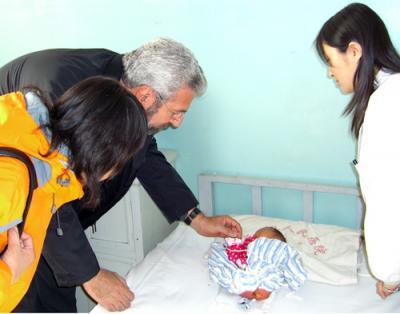AUSTIN, Texas — Pesticides and pollutants are related to an alarming 450 percent increase in the risk of spina bifida and anencephaly in rural China, according to scientists at The University of Texas at Austin and Peking University.
Two of the pesticides found in high concentrations in the placentas of affected newborns and stillborn fetuses were endosulfan and lindane. Endosulfan is only now being phased out in the United States for treatment of cotton, potatoes, tomatoes and apples. Lindane was only recently banned in the United States for treatment of barley, corn, oats, rye, sorghum and wheat seeds.
Strong associations were also found between spina bifida and anencephaly and high concentrations of polycyclic aromatic hydrocarbons (PAHs), which are byproducts of burning fossil fuels such as oil and coal. Spina bifida is a defect in which the backbone and spinal canal do not close before birth. Anencephaly is the absence of a large part of the brain and skull.
"Our advanced industrialized societies have unleashed upon us a lot of pollutants," says Richard Finnell, professor of nutritional sciences and director of genomic research at the Dell Children's Medical Center of Central Texas. "We've suspected for a while that some of these pollutants are related to an increase in birth defects, but we haven't always had the evidence to show it. Here we quite clearly showed that the concentration of compounds from pesticides and coal-burning are much higher in the placentas of cases with neural tube defects than in controls."
The study, which was published in August in the Proceedings of the National Academy of Sciences, is the result of a more than decadelong collaboration between Finnell and a team of researchers in Shanxi, a province in northern China.
Finnell sought collaborators in China because the prevalence of neural tube defects is much greater there than it is in the United States. Also, because of its population policies, China is good at tracking births.
"It's an extraordinary natural experiment," says Finnell, who was recently recruited to the university to help anchor the Dell Pediatric Research Institute. "It would be much harder to do this study in the United States, where neural tube defects are more rare. It's also an opportunity to assist the Chinese government in their efforts to lower their birth defect rates."

Richard Finnell checks on a newborn in Shanxi Province.
(Photo Credit: Image courtesy of Richard Finnell)
Working with public health officials in four rural counties in Shanxi, researchers collected placentas from 80 newborn or stillborn fetuses that suffered from spina bifida or anencephaly. Once a fetus or a newborn with such defects was identified as a case, the placenta of a healthy newborn with no congenital malformations born in the same hospital was selected as a control.
Finnell and his colleagues screened these placentas for the presence of a class of substances known as persistent organic pollutants (POPs). Common POPs include agricultural pesticides, industrial solvents and the byproducts of burning fuels such as oil and coal.
They found strong associations between the birth defects and high levels of a number of compounds present in commonly used pesticides. They also found elevated placental concentrations of PAHs.
"This is a region where they mine and burn a lot of coal," says Finnell. "Many people cook with coal in their homes. The air is often black. You don't need to be a rocket scientist to say that maybe there's something in there that isn't good for babies."
Finnell says although the environmental conditions in Shanxi are dramatically worse than they are in most areas of the United States, they are comparable to what the United States was like a century ago, and the neural tube defects are not solely a Chinese problem.
Every year approximately 3,000 pregnancies in the United States are complicated by neural tube defects. Many other congenital conditions, including autism, may one day prove to be related to environmental pollutants.
"Ultimately you need enough cells to make a proper, healthy baby," says Finnell, "and these are the types of compounds that cause cell death. At the most basic level, we're learning that environmental things kill cells, and if that occurs in a critical progenitor population at a crucial time, you're going to have problems."
Source: University of Texas at Austin